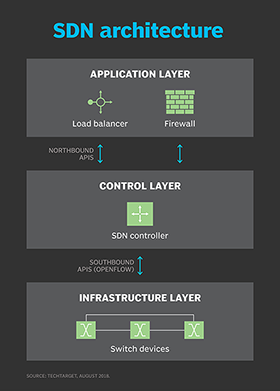What is open networking?
Open networking describes a network that uses open standards and commodity hardware. It is an umbrella term that describes a general use of open standards. With open networking, a computer system can have open hardware and software component compatibility, expandability and extendibility.
Open networking is similar to open standards, which focus on creating interoperability and data exchange standards around general and public consensus-driven processes. An open network opposes the idea of a closed network, which limits networks by a set of providers.
Network administrators benefit from an open networking system because they can freely choose what types of hardware and software make up their network without relying on a single vendor's products. Organizations can find open source options for routers, switches, firewalls or load balancers to help create and maintain an open network.
The main benefits of open networking include the following:
- Greater cost savings compared to proprietary vendor products.
- More configurability.
- Easier ability to add applications or tools directly onto existing hardware.
How to define open networking
Open networking doesn't have a rigid definition; the extent of the term might differ based on the individual. Open networking can mean something broad, such as the level of network interoperability and substituting one component for another.
Others might have a more narrow definition for open networking, such as an approach to software-defined networking (SDN) with open source protocols. Open networking could also mean pairing an open source network operating system (OS) with publicly available hardware in a virtual machine.
Vendors also have different meanings for open networking. A vendor might define it as conforming to existing networking standards or using a set of publicly sourced application programming interfaces (APIs) that work with other tools. Vendors also define open networking as the level of openness of their own network rather than other standards around them. The term also relates to white box networking.
Characteristics of an open network
Open networking products typically share the following characteristics:
- Open APIs.
- Open industry standards related to hardware and software.
- Open source components, such as network devices and compute hardware.
- Open ecosystem that cooperates with other types of tools and hardware.
- Cloud computing.

SDN in open networking
SDN is a common aspect of open networks. SDN architecture aims to make networks more flexible to improve network control. It contains an application layer, a control layer and an infrastructure layer and enables network administrators to view traffic from a centralized control console.
Operators can manage entire networks and devices with a control layer, even if the underlying network is complex. This enables enterprises and service providers to respond and adapt quickly to changing business requirements.
SDN works well with open networking because it enables multivendor interoperability and supports a multivendor approach to networking. Open networking uses SDN principles, while adding open source platforms and defined standards. SDN networks typically use open APIs, which support many applications, while publicly available software manages hardware from different vendors that use open program-based products.
Open Networking Foundation
The Open Networking Foundation (ONF) was a nonprofit organization that promoted a collaborative community focused on open networking. ONF developed software-defined standards for open networking.
In 2023, ONF merged with The Linux Foundation and created three new projects as a result:
- LF Broadband.
- Aether.
- P4.
Open networking examples
Applying open networking principles is as broad as the term. However, organizations can use an open source controller OS to manage lower-cost hardware across a computer network.
In September 2019, Comcast and ONF deployed Trellis, an open source software. Trellis is an architecture pattern that develops SDN- and network functions virtualization-based fabrics for network services. Trellis works with an open source SDN controller and an OpenFlow protocol that functions as a southbound API.
An OpenFlow protocol enables servers to tell network switches where to send packets. OpenFlow is a standard communication interface that separates the control and forwarding layers of an SDN-based architecture.
In conventional networks, each switch has proprietary software that tells the switch what to do. Comparatively, OpenFlow centralizes packet-moving decisions. This means it's possible to program the network independently of the individual switches and data center gear.







